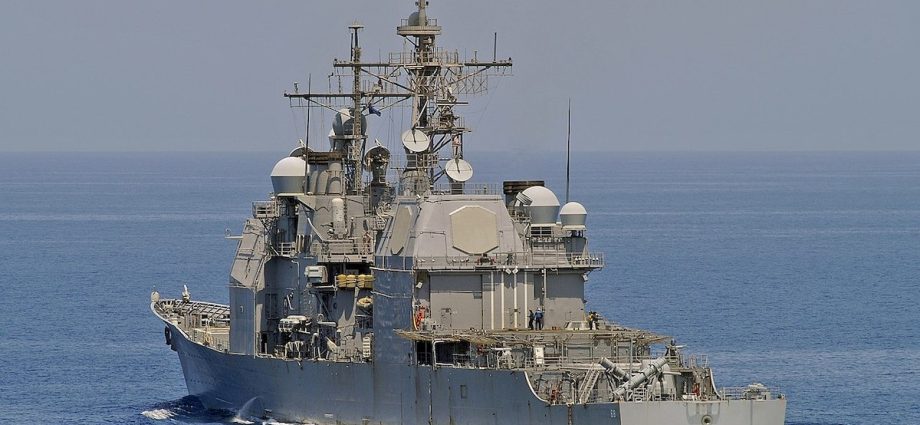The US is expediting development of its DDG(X) next-generation destroyer, a design that will replace its aging Ticonderoga-class cruisers and maxed-out Arleigh Burke-class destroyers.
This month, National Defense Magazine reported that the US Navy had requested US$187.4 million in funding for DDG(X) research and development. The report notes that the destroyer’s initial design prescribes a displacement of 13,500 tons, nearly 40% larger than its Arleigh Burke predecessor.
It also mentions that the DDG(X) will initially have the same weapons as the Arleigh Burke Flight III ships, including the Aegis missile defense system and two 21-cell Rolling Airframe Missile launchers.
National Defense Magazine notes that upgradeability is a significant design consideration for the DDG(X), with the class envisioned to operate lasers and hypersonic missiles.
The report notes that the class will use an Integrated Power System (IPS) to power those weapons, with the added capability for the ship’s crew to allocate power to either propulsion or weapons systems in real time.
The source mentions that DDG(X) will begin production in 2030, with an average cost ranging from US$3.1 billion to US$3.4 billion, according to US Congressional Budget Office (CBO), and US$2.3 billion to US$2.4 billion according to US Navy estimates.
The US Navy’s aging Ticonderoga-class cruisers and maxed-out Arleigh Burke-class destroyers may be long overdue their replacements, considering China’s rapid naval modernization and expansion.
The US Navy wants to retire its 22-ship Ticonderoga-class cruiser fleet in five years despite their formidable armament and the strategic fact that they are the only ships capable of acting as a central operations center for US carrier strike group’s air warfare commander, Howard Atman writes in an April 2022 article for The Warzone.
Altman writes that, on average, Ticonderoga-class cruisers are 35-years-old and are deteriorating, suffering from cracking and structural issues, obsolescence and supportability issues, with the substantial cost of repairing the ships outweighing their remaining war-fighting value.

Meanwhile, Caleb Larson notes in a June 2020 article for The National Interest that Arleigh Burke-class destroyers have been improved to the maximum. Larson notes that the Arleigh Burke’s internal space limitations don’t allow for improved power generation onboard, meaning newer communications, radar, directed energy weapons and propulsion systems cannot be installed.
While the DDG(X) aims to solve the problems associated with Ticonderoga-class cruisers and Arleigh Burke-class destroyers, there are concerns about the project’s strategic value, operational viability and sustainability.
Ronald O’Rourke opines in a February 2022 article for National Defense Magazine that the US Navy should provide clarification on the DDG(X)’s proposed new capabilities and enlarged payload capacity, especially as game-changing technologies such as lasers and hypersonic weapons are still in an immature development phase.
Meanwhile, a March 2023 Congressional Research Service (CRS) report outlines the DDG(X) project’s operational challenges.
The report asks whether a large surface combatant like the DDG(X) would be compatible with the US Navy’s Distributed Maritime Operations (DMO) concept, which envisions a future fleet with a force mix with a smaller proportion of larger ships and a bigger proportion of smaller ships.
Andrew Davies notes in January 2022 article for The Strategist that the rational response to increased lethality on the battlefield, including the naval domain, is greater dispersion of forces. However, the DDG(X) moves in the opposite direction by putting so much capability into one potentially vulnerable asset.
The CRS report also asks whether a new variant of the Arleigh Burke-class destroyer would be more cost-effective than the DDG(X)’s all-new design.
In a March 2023 article for Popular Mechanics, Kyle Mizokami notes that upgrade packages could keep the Arleigh Burke viable until 2031, with the latest Arleigh Burke Flight III ships sporting a more powerful SPY-6 radar, new Rolls-Royce generators capable of generating 33% more electricity and 96 vertical-launch system missile silos.
Although an Arleigh Burke Flight IV was previously in the works, the type was canceled in 2014 as the US Navy prioritized building nuclear ballistic missile submarines (SSBN) over surface warships. The Arleigh Burke Flight IVs would have had the same air defense commander capability housed in the aging Ticonderoga-class cruisers.
The CRS report meanwhile asks if the US Navy has fully considered the DDG(X)’s required operational capabilities aside from outmatching near-peer adversaries’ similar warships.
Bradley Martin notes in a January 2023 Naval News interview that the DDG(X) will require longer-ranged weapons, better command and control capability over dispersed units, the ability to replenish vertical launch systems at sea and an improved ability to use decoys and other deception systems.
In addition, the CRS report also asks whether the US Navy has accounted for the transition from the Arleigh Burke-class to the DDG(X) in terms of procurement and industrial base. Asia Times reported in February 2023 that while the US has seven naval shipyards, China has 13 facilities, each with more capacity than all seven US naval shipyards combined.

Such formidable shipbuilding prowess has made the People’s Liberation Army–Navy (PLA-N) the largest in the world with 340 ships, with the US Navy now the second-largest at 280 ships. The PLA-N is expected to grow to 400 ships by 2025 and 440 by 2030, with much of that growth coming from major combatants like cruisers and destroyers.
In contrast, the Biden administration’s 2023 plan for naval ship purchases and retirements, under three alternative scenarios, would all see the US fleet size shrink over the next ten years before increasing in size, according to a Congress Budget Office report.
Although US ships are more advanced, quality cannot replace quantity and physical presence, with the US Navy possibly placing too much faith in exorbitantly overpriced and unproven designs and technology.

